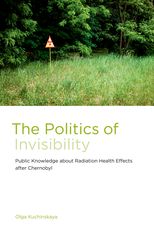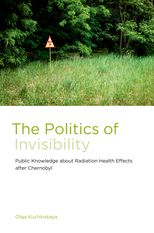The Politics of Invisibility: Public Knowledge about Radiation Health Effects after Chernobyl
The Politics of Invisibility: Public Knowledge about Radiation Health Effects after Chernobyl
Cite
Abstract
Before Fukushima, the most notorious large-scale nuclear accident the world had seen was Chernobyl in 1986. The fallout from Chernobyl covered vast areas in the Northern Hemisphere, especially in Europe. Belarus, at the time a Soviet republic, suffered heavily: nearly a quarter of its territory was covered with long-lasting radionuclides. Yet the damage from the massive fallout was largely imperceptible; contaminated communities looked exactly like non-contaminated ones. It could only be known through constructed representations of it. The book explores how we know what we know about Chernobyl, describing how the consequences of a nuclear accident were made invisible. The analysis sheds valuable light on how we deal with other modern hazards—toxins or global warming—that are largely imperceptible to the human senses. The book describes the production of invisibility of Chernobyl’s consequences in Belarus—practices that limit public attention to radiation and make its health effects impossible to observe. Just as mitigating radiological contamination requires infrastructural solutions, the production of invisibility also involves infrastructural efforts, from categorical work of redefining the scope and nature of the accident’s consequences to reshaping infrastructures for research and radiation protection. The book finds historical fluctuations in recognition, tracing varyingly successful efforts to conceal or reveal Chernobyl’s consequences at different levels—among affected populations, scientists, government, media, and international organizations. The production of invisibility, the book argues, is a function of power relations.
Sign in
Personal account
- Sign in with email/username & password
- Get email alerts
- Save searches
- Purchase content
- Activate your purchase/trial code
Institutional access
-
Sign in through your institution
- Sign in with a library card Sign in with username/password Recommend to your librarian
Institutional account management
Sign in as administratorPurchase
Our books are available by subscription or purchase to libraries and institutions.
Purchasing information| Month: | Total Views: |
|---|---|
| November 2022 | 4 |
| November 2022 | 3 |
| November 2022 | 3 |
| November 2022 | 6 |
| November 2022 | 2 |
| November 2022 | 4 |
| November 2022 | 5 |
| November 2022 | 2 |
| November 2022 | 4 |
| November 2022 | 2 |
| November 2022 | 2 |
| November 2022 | 4 |
| November 2022 | 2 |
| November 2022 | 4 |
| February 2023 | 4 |
| February 2023 | 2 |
| February 2023 | 2 |
| February 2023 | 4 |
| February 2023 | 2 |
| April 2023 | 3 |
| April 2023 | 5 |
| April 2023 | 2 |
| April 2023 | 2 |
| April 2023 | 2 |
| April 2023 | 6 |
| April 2023 | 1 |
| May 2023 | 1 |
| May 2023 | 1 |
| May 2023 | 1 |
| May 2023 | 1 |
| May 2023 | 1 |
| October 2023 | 3 |
| December 2023 | 1 |
| January 2024 | 1 |
| February 2024 | 1 |
| February 2024 | 1 |
| February 2024 | 4 |
| February 2024 | 1 |
| April 2024 | 1 |




Get help with access
Institutional access
Access to content on Oxford Academic is often provided through institutional subscriptions and purchases. If you are a member of an institution with an active account, you may be able to access content in one of the following ways:
IP based access
Typically, access is provided across an institutional network to a range of IP addresses. This authentication occurs automatically, and it is not possible to sign out of an IP authenticated account.
Sign in through your institution
Choose this option to get remote access when outside your institution. Shibboleth/Open Athens technology is used to provide single sign-on between your institution’s website and Oxford Academic.
If your institution is not listed or you cannot sign in to your institution’s website, please contact your librarian or administrator.
Sign in with a library card
Enter your library card number to sign in. If you cannot sign in, please contact your librarian.
Society Members
Society member access to a journal is achieved in one of the following ways:
Sign in through society site
Many societies offer single sign-on between the society website and Oxford Academic. If you see ‘Sign in through society site’ in the sign in pane within a journal:
If you do not have a society account or have forgotten your username or password, please contact your society.
Sign in using a personal account
Some societies use Oxford Academic personal accounts to provide access to their members. See below.
Personal account
A personal account can be used to get email alerts, save searches, purchase content, and activate subscriptions.
Some societies use Oxford Academic personal accounts to provide access to their members.
Viewing your signed in accounts
Click the account icon in the top right to:
Signed in but can't access content
Oxford Academic is home to a wide variety of products. The institutional subscription may not cover the content that you are trying to access. If you believe you should have access to that content, please contact your librarian.
Institutional account management
For librarians and administrators, your personal account also provides access to institutional account management. Here you will find options to view and activate subscriptions, manage institutional settings and access options, access usage statistics, and more.